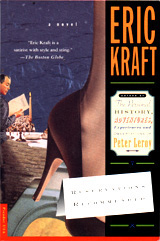
YOU CAN READ
|
“Playing?” “On my computer.” “A computer game,” says Harold. “Not a game,” says Belinda. “Not a game,” says Harold, shaking his head at Gwen as if she had mistaken whatever it is for a game. “It’s something Belinda is developing. ‘Picture Frame.’ It’s partly a mystery,” says Matthew. “More like a mystery,” Harold says, again to Gwen. “Not really,” says Belinda. “It does have things in common with a mystery or computer games, adventure games, but it’s really not a game. You don’t win, you know? I mean, you don’t even try to win, winning is irrelevant, just not in the picture. So it isn’t like a game. And you don’t try to solve anything, so it isn’t like a mystery. You just find things out. You find things out about characters, and ideas, and things that have happened to people, so it’s more like, well, snooping, spying on someone.” “More like snooping,” Harold informs Gwen. You jerk, thinks Belinda. “I’m not really ready to talk about it,” she says. “It’s still rough. Matthew’s just been trying it out.” “I’m not getting it,” says Gwen. “Well,” says Belinda. “Just to give you an idea—imagine that you’re looking at your computer screen.” Gwen shudders theatrically. “The prospect terrifies me, but go ahead.” “You’re a computer-phobe?” asks Belinda. “Definitely,” says Gwen, “but go on.” Belinda’s estimation of Gwen drops very low indeed. “Hmm,” she says. “That’s interesting. Well, if you can do it without making yourself sick, imagine that you’re looking at the screen and there’s a page of text on it. But some of the words and phrases are active. If you click your mouse—” “Oh, dear. I was afraid we were going to hear about the dreaded mouse. Just the idea of clicking my mouse sounds obscene.” “You click your cursor, then—” “A curse on cursors!” cries the witty Harold. “—on one of these active words,” continues Belinda without a pause, “you go immediately to some other text. Okay?” “Is it okay, Gwen dear?” asks Harold. To Belinda he says, “You have to excuse her, she’s quite the little Luddite. It’s part of her charm.” Belinda decides that she despises Harold, utterly. Nothing he could possibly do could change her opinion. “The text you jump to,” Belinda continues, determined now not to be stayed, “is related to the word you clicked on—in some way. It adds something to it, or it takes you somewhere that’s related to it. I’m not doing a very good job, am I?” “Is this what happens in theory,” Gwen asks, “or what really happens in the game?” “Uh-uh-uh,” cautions Harold. “Sorry,” says Gwen. “The—whatever you call it.” “I want you to understand how it works,” says Belinda, “before I get into the game itself. Oh, shit, now I’m doing it. Call it a game—who cares? Suppose you click on the name of a character—zip—you’re into something about that character’s childhood. You find out that he”—an instant’s pause—“was an orphan, or something like that. But it’s not all text, you see, there are illustrations, too. And they have active elements.” With her finger, she draws on the tablecloth. “You might have a drawing of this table, from above, with Harold here, me here, Matthew here, and Gwen here. We’d all be active elements. Click on Harold, and some text might appear on the screen, or a new picture, anything. But it would tell you something more.” “Like what?” asks Gwen. “Oh, that his hand is on my knee, or whatever.” A pause. “Just kidding,” she says. “Why the name?” asks Harold. “Picture Frame?” “Ah!” says Belinda. “Well, when you start playing—‘playing’—I don’t believe I said that. Maybe it isa game. Anyway—when you start, you think you’re in someone’s apartment, and you work your way around in it, checking things out—you can look into her diary, listen to the messages on her answering machine, read some of her mail, look at the art on her walls, and so on. So you learn a lot about her. But the best thing you discover is that she’s got a computer. You start it up, and there’s a lot more you can discover about her there. But one of the things on her disk is Picture Frame. This game. When you open it up, though, it’s not the same. You’re not in the same apartment. You’re in someone else’s apartment.” Belinda’s a little breathless. This is the first time she’s explained her game to someone she doesn’t know. She’s excited and anxious. “And I’ll bet he’s got a computer, too,” says Harold. “She. But you’re right. And much later, after you’ve been here and there, you find out that when you first started you weren’t really in an apartment at all—you were wandering around in a picture of an apartment. A snapshot that’s lying in a desk drawer in a room in an inn on an island. And so you can go right back to the beginning. So the question is, when have you been in the picture, and when have you been in the frame?” She’s done. She reaches for her glass and is surprised to find that her hand trembles. “This would drive me back to drink,” says Gwen. “Probably,” says Belinda, with a venomous smile. “But why do you do it?” asks Harold. “Oh, I just started fooling around,” says Belinda. “I have played a lot of computer games, and I thought it would be interesting to try to do something that was set in this time, instead of the usual medieval epic—” “No, I mean why does the player do it—keep playing?” “Hm?” “I mean, what’s the point?” “Well, it’s intriguing—I hope.” “Forgive me, but I think I can give you some advice. You know, you’re touching on my business here. Mine and Matthew’s. So I think I can give you some help. You’ve got to have something to keep up people’s interest. Put yourself in the position of somebody who might play this Picture Frame. Somebody who might buy it. Now suppose that’s me. Why should I care about this? Why should I spend my time on it? What do I get out of it? Usually, if I’m going to sit at a computer, I’m going to be doing something practical. But you’re asking me to sit there just out of curiosity. I’m not going to make more money by playing this. I’m not going to improve myself. So why should I bother? You see what I’m saying? You need some mystery or something to keep my interest. Throw in a body. A dead body. That’s what you’ve got to have. Keep up the interest.” |
 |
||
|
RESERVATIONS
RECOMMENDED | CHAPTER 3, PART 6 | CONTENTS
PAGE
|

 Here
are a couple of swell ideas from Eric Kraft's vivacious publicist, Candi
Lee Manning:
Here
are a couple of swell ideas from Eric Kraft's vivacious publicist, Candi
Lee Manning:
